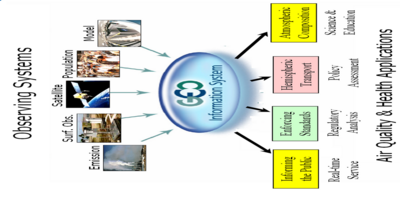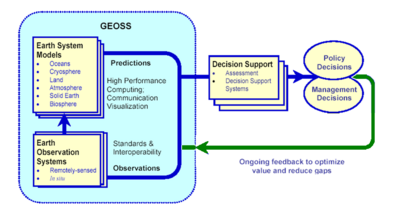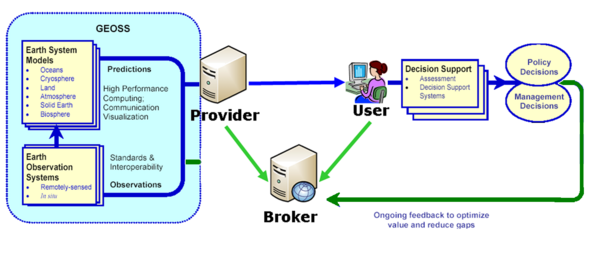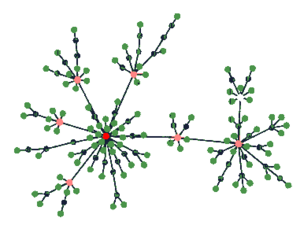NASA ACCESS09: Tools and Methods for Finding and Accessing Air Quality Data
Air Quality Cluster > AQIP Main Page > Proposal | NASA ACCESS Solicitation | Context | Resources | Forum | Participants
Tools and Methods for Air Quality Information Infrastructure Partnership
- NASA
- NOAA
- EPA
- DOE (NARSTO)
Background
From ACCESS solicitation: Many exisiting web-based services in NASA are applicabe to Earth Science (ES) but are not well exposed and not easily discoverable by potential users. Furthermore, users searching for NASA ES data often do not have broad knowledge of pertinent services pertinent to their data of interest.
Proposals should address this information gap by providing tools and methods for discovery and use of data services provided by NASA, other Federal agencies, academia..and components for persistent availability of these services through service and GUI interfaces.
Problem
- The Users Dilemma (direct problem)
- There are no data for what the user needs
- If there are needed data, the user can not find them
- If the user can find them, she can not access them
- If the user can access then, she does not know how good they are
- If he knows how good they are, she can not merge them with other data.
- Providers Dilemma (indirect problem)
- There are no users for the data
- If there are users, the provider can not find them
- If she can find data, she does not know how to deliver them
- If she can deliver them, she does not know how to make it valuable
- If the she can make it more valuable...
- Lots of data resources in NASA, elsewhere. Most data are not available as services.
- if it is a service, e.g. openDaP, may need rich clients, hard coded, loose coupling not easy
- Even if reusable service is available it cannot be found.
Data Value Chain Stages: Acquisition - Mediation - Application
- Acquisition: Data from Sensor -> CalVal -> Data exposed
- Mediation: Accessible/Reusable -> Leverable
- Application: Processed -> LeveragedSynergy -> Productivity
Provider and User Oriented Designs
- Providers offers it wares ... to reach maxinum users in many applications
Approach
- Service Orientation, while accepted has not been widely adapted for serving NASA products
- SOA allows the creation of loosely coupled, agile, data systems
- SOA -> requires ability to Publish, Find, Bind (Register, Discover, Access)
- Stages: Acquisition, Repackaging, Usage
- Acquisition is a stovepipe
- Usage is value chain
- In-between is the 'market'
The Network
- Fan-In, Fan-Out
- (so is GCI) not central
- holarchy , data up into the pool though the aggregator network and down the disaggregator/filter network
- Data distributed through Scale-free aggregation network. Metadata contributed along the line of usage. Homogenized and shared.
Data Service Publication
- Data as Service
- Wrappers, reusable tools and methods ( dataset classes)
- To illustrate the Network, Coding (faceting) through metadata, WMS to show data
- WCS next
- Binding to data through standard data access protocols, publishing and finding requires metadata system
Data Discovery
- Semantic Mediation - Repackaging/homogenizing metadata - added value comes from incorporating user actions back into the semantic relationships.
- Metadata system for publishing and finding content has to be jointly developed between data providers and users.
- Generic catalog systems - metadata collection of not only what provider has done but also tracking what users need
- Collecting and Enhancing Metadata from observing Users
- Communication along the value chain, in both direction;
- Metadata the glue and the message
- Market approach; many providers; many users; may products
- Faceted search
- user is happy
- Search by usage data
Description on how users will discover and use services provided by NASA, other Agencies, academia..
- Detail on discovery services
- System components for persistent availability of these services
- machine-to-machine interface
- GUI interface
Classes of Users
- by value chain
- by level of experience
- by ...
Data Assess and Usage
Provider Oriented Catalog:
- All data from a provider (subset fall data)
- Metadata only (Standard protocol)
- Provider metadata (meta-meta-meta data)
User Oriented Catalog:
- The right data (subset fall data)
- Seamlessly accessable (Standard protocol)
- Complete Metadata (meta-meta-meta data)
Performance Measurement and Feedback
Metadata from Providers
Metadata from Users
- Google Analytics/Google Sitemap - provides feedback and helps market process by improving "shopping" experience for users - creates values to both users and producers.
- Amazon - collects data on user actions in order to help the next user navigate to books of interest. collects data on text in the book in order to relate books together
Metadata from Mediators
Management
Partnership
- Toward an Air Quality Information Partnership (AQIP)
- Agencies: EPA, NASA, NOAA, DOE ....
- Intrastructure first
links
ESIP
- Data_System_Governance_and_Sustainability and Synery
- Interoperability_of_Air_Quality_Data_Systems
- Data_Systems_Architecture
- Desired_Characteristics_of_Air_Quality_Data_Systems
- Air_Quality_Data_Processing_and_Portal_Systems
- Air_Quality_Data_Providers
- AQ_Data_System_Applications Clients_and_User_Groups
- Community_Air_Quality_Data_Systems_Strategy
- AQ_Data_System_Strategy_Introduction_and_Purpose
DataFed wiki
- Interoperability_in_DataFed_Service-based_AQ_Analysis_System
- 2008-07-07_EPA_Interoperability
- HTAP Interoperability Husar060126_HTAP_Geneva
- 2008-02-11:_EPA_DataFed_Presentation
- DataFed Collaboration Projects
- 2008-02-29:_Data_&_Knowledge_Differences_on_Interop_Stack
- 2006-06-28_ESTO,_College_Park
NASA Existing Component - Links
- Atmosphere Data Reference Sheet - Datasets identified to be relevant to atmospheric research.
- Giovanni - that provides a simple and intuitive way to visualize, analyze, and access vast amounts of Earth science remote sensing data without having to download the data GIOVANNI metadata describes briefly parameter
- parameter information pages - provide short descriptions of important geophysical parameters; information about the satellites and sensors which acquire data relevant to these parameters; links to GES DAAC datasets which contain these parameters; and external data source links where data or information relevant to these parameters can be found.
- Mirador new search and order Web interface employs the Google mini appliance for metadata keyword searches. Other features include quick response, data file hit estimator, Gazetteer (geographic search by feature name capability), event search
- Frosty
- GCMD - Has selected Air Quality datasets; provides lots of discovery metadata keywords, citation, etc. lacks standard data access.
- A-Train Data Depot - to process, archive, allow access to, visualize, analyze and correlate distributed atmospheric measurements from A-Train instruments.
- Atmospheric Composition Data and Information Service Center - is a portal to the Atmospheric Composition (AC) specific, user driven, multi-sensor, on-line, easy access archive and distribution system employing data analysis and visualization, data mining, and other user requested techniques for the better science data usage.
- WIST - Warehouse Inventory Search Tool. search-and-order tool is the primary access point to 2,100 EOSDIS and other Earth science data sets
- FIND - The FIND Web-based system enables users to locate data and information held by members of the Federation (DAACs are Type 1 ESIPs.) FIND incorporates EOSDIS data available from the DAAC Alliance data centers as well as data from other Federation members, including government agencies, universities, nonprofit organizations, and businesses.



